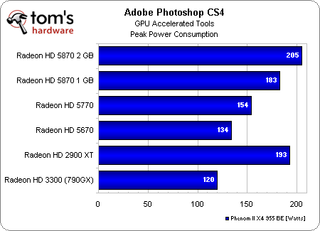AMD's Radeon HD 5000-Series: Measuring Power Efficiency
Most of our graphics card reviews include power measurements at idle and load. But how do applications tax your GPU in between those two extremes? We line up a handful of different programs and monitor power use with a handful of AMD's latest cards.
Benchmark Results: Desktop Usage, Less-Than-Ideal Conditions
We know how these cards perform under a typical benchmark. Now, let's turn our attention to other usage scenarios, mainly desktop-based workloads. Most apps outside of the gaming world really don’t make use of GPU-based acceleration. Those that do are typically graphics-related titles, along with a handful of video playback apps. Today, we're going to use a handful, including Adobe Photoshop CS4, Cinebench R11, and Cyberlink's PowerDVD 9 to play a H.264 video file. Let's see how they do in less-than-ideal, real-life usage conditions.
Adobe Photoshop CS4
Although we can’t generate performance figures using Photoshop, we can definitely say that the title only really needs an add-in graphics card capable of OpenGL support. GPU acceleration does work on the integrated Radeon HD 3300 processor, but stuttering was still apparent during zoom and rotate functions.

We were slightly surprised to see Photoshop CS4's GPU utilization. It occasionally rises above 50% during the test (particularly while zooming in on an image and rotating the view). This makes it an interesting benchmark, because we can see how these cards fare when we don't fully utilize all their available processing power. The graph above comes from measurement data taken with two successive, manual runs. As you can see, peak power consumption stays pretty much around the 140 W mark.

Here's the kicker. Since GPU-based performance is practically the same with most discrete graphics cards, the board with the lowest (peak) power consumption is the one you want to get for Photoshop. Of the graphics tested in this article, our winner is AMD’s Radeon HD 5670. The card manages to eat up an additional 14 W on top of the base system’s power consumption.
Stay on the Cutting Edge
Join the experts who read Tom's Hardware for the inside track on enthusiast PC tech news — and have for over 25 years. We'll send breaking news and in-depth reviews of CPUs, GPUs, AI, maker hardware and more straight to your inbox.
Current page: Benchmark Results: Desktop Usage, Less-Than-Ideal Conditions
Prev Page Benchmark Results: Crysis, The Classic Approach Next Page Benchmark Results: Cinebench R11-
tony singh Very innovative article tom keep it up!! Similar article consisting of various cpus would be really useful.Reply -
spidey81 I know the FPS/watt wouldn't be as good, but what if the 5670 was crossfired. Would it still be a better alternative, efficiency wise, than say a 5850?Reply -
nforce4max Remember the R600 (2900xt) has a 80nm core while the 5870 has a 45nm core. Shrink the R600 and you will get the 3870 (55nm) that barely uses hardly any.Reply -
rhino13 And now just for fun we should compare to Fermi.Reply
Oh, wait, this just in:
There is a Fermi comparison chart that was avalible but you needed to have two screens to display the bar graph for Fermi's power consumption and temperature. So the decission was made to provide readers with the single screen only version.
-
aevm I loved this part:Reply
A mere 20 watts separate the Radeon HD 3300, HD 5670, HD 5770, and HD 5870 1 GB. So, in certain cases, the Radeon HD 5870 1 GB can still save enough power to close in on its more mainstream derivatives. Again, this is the case because the cards use a fixed-function video engine to assist in decoding acceleration, which is the same from one board to the next. Thus, even a high-end card behaves like a lower-end product in such a workload. This is very important, as you will see later on.
My next PC will be used mostly for movie DVDs and Diablo 3. Apparently if I get a 5870 1GB I get the best of both worlds - speed in Diablo and low power consumption when playing movies.
How about nVidia cards, would I get the same behavior with a GTX 480 for example?
-
Onus For those not needing the absolute maximum eye candy at high resolutions in their games, the HD5670 looks like a very nice choice for a do-it-all card that won't break the budget.Reply
Next questions: First, where does the HD5750 fall in this? Second, if you do the same kinds of manual tweaking for power saving that you did in your Cool-n-Quiet analysis, how will that change the results? And finally, if you run a F@H client, what does that do to "idle" scores, when the GPU is actually quite busy processing a work unit? -
eodeo Very interesting article indeed.Reply
I'd love to see nvidia cards and beefier CPUs used as well. Normal non green hdds too. Just how big of a difference in speed/power do they make?
Thank you for sharing. -
arnawa_widagda Hi guys,Reply
Thanks for reading the article.
Next questions: First, where does the HD5750 fall in this? Second, if you do the same kinds of manual tweaking for power saving that you did in your Cool-n-Quiet analysis, how will that change the results? And finally, if you run a F@H client, what does that do to "idle" scores, when the GPU is actually quite busy processing a work unit?
Have no 5750 sample yet, but they should relatively be close to 5770. For this article, we simply chose the best bin for each series (Redwood, Juniper and Cypress).
The second question, what will happen when you tweak the chip? Glad you ask!! I can't say much yet, but you'll be surprised what the 5870 1 GB can do.
As for NVIDIA cards, I'm hoping to have the chance to test GF100 and derivatives very soon.
Take care.
Most Popular

